The Green Movement in Iran was a model for peaceful demonstrations in which the protestors demanded reform regarding civil rights and social freedoms. It all began during the 2009 Iranian presidential election, which citizens believed was fraudulent. When Mahmoud Ahmadinejad declared his victory, the people of Iran took to the streets. The people thought that the true winner should have been his opponent, former Prime Minister Mir-Hossein Mousavi, who also declared that he had won the same time Ahmadinejad claimed he had won. 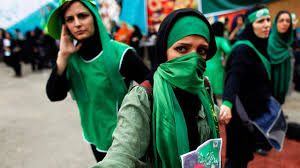 The chant “Where Is My Vote?” rang out in the city of Tehran in clear opposition to the results of the election. These protests were initially peaceful, but then spiraled out of control. Protesters yelled “Down with the dictator” and other phrases that were clearly anti-regime. Al Jazeera claimed that this was the “biggest unrest since the 1979 revolution” (Al Jazeera). The largest and most physical protests occurred near universities, where students made up the majority of the protesters. On June 20, ten protestors were killed. One of the casualties was student Neda Agha-Soltan, who became a symbol of the revolution and was depicted in numerous murals and public art.
The chant “Where Is My Vote?” rang out in the city of Tehran in clear opposition to the results of the election. These protests were initially peaceful, but then spiraled out of control. Protesters yelled “Down with the dictator” and other phrases that were clearly anti-regime. Al Jazeera claimed that this was the “biggest unrest since the 1979 revolution” (Al Jazeera). The largest and most physical protests occurred near universities, where students made up the majority of the protesters. On June 20, ten protestors were killed. One of the casualties was student Neda Agha-Soltan, who became a symbol of the revolution and was depicted in numerous murals and public art.
Religious cleric Ayatollah Ali Khamenei asked for an investigation into vote rigging allegations, but ultimately the religious leaders urged the public to support Ahmadinejad.
These protests continued until February 14, 2010, when the government had enough and struck back. The government wanted Mir Hussein Moussavi dead for his role of leading the opposition.
The Telegraph reported that the Iranian government was censoring the news coverage of the protests and the allegations of poll rigging. BBC World Service also accused the Iranian Government of censoring their material into Iran, including their coverage of the protests and the election. BBC reporter John Simpson was actually arrested in Tehran as well. The offices of different news agencies were looted by the government, and material was stolen.
There was a recount of the votes, and the recount was televised on state TV in order to appease the protestors. The recount still held that Ahmadinejad still won.
Iran was not an Arab Spring revolution country. Instead, Iran is considered to be a country that participated in a New Social Movement. This movement had a lot of similarities with the Arab Spring movements in Egypt and Tunisia especially. These protests were all concerned with the transitions of power between leaders, and the validity of elections were called into question. In addition, all of the Arab Spring movements I followed had issues regarding government censorship.
Iranian Green Movement Art
A lot of the art during this wave of political unrest was not so much street art. There were not as many murals as there were in Egypt or Tunisia, but there were smaller tags.
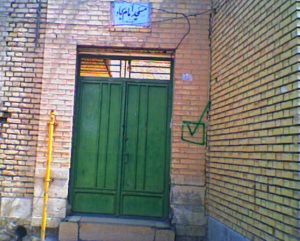
This is one of the most common forms of street art that was found throughout Tehran during the Green Revolution protests. The green check mark in the green box symbolizes the check on an election ballot. The green color is adopted from the opposition party’s color–green to symbolize new growth.
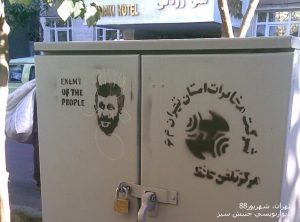
This specific stencil on the left side depicts Ahmadinejad with the text, “enemy of the people.”
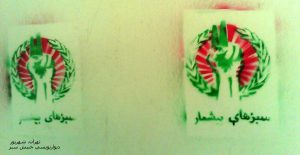
I do believe that this movement was just another example of the Iranian tendency to engage in collective action to protest for political freedoms and for fair and free elections. One Iranian who truly embodies the idea of speaking out about political imbalances and injustices is the artist Black Hand.
Commonly referred to as the Middle Eastern Banksy and the Iranian Banksy, Black Hand has been known to create murals out of stencils throughout various cities in Iran. And–interestingly enough–she is the only woman who I discovered to be a prominent street artist in the Middle East. In 1979, Iran underwent a significant revolution. Both the opposition and those who supported the government during that revolution created large murals of the Shah and other figures to show their support for their side. After the revolution, street art was classified by the government as vandalism, and the art form died down, aside from state-sanctioned pieces aligned with the government’s positions on certain stances. Fast forward to 2014, and Black Hand is challenging the government with her art.
Her art focuses on social and political issues at the forefront of conversations in Iran.
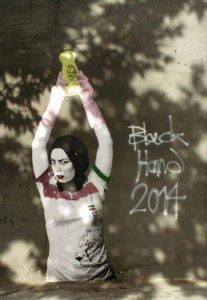
Pictured here is her piece in which a woman is wearing a soccer jersey, holding a bottle of dish soap as if it were the World Cup Trophy. This was created in response to a law that forbid women from attending soccer games.
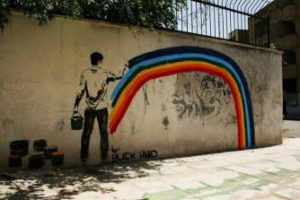
In this mural, Black Hand displays her opinions on gay rights in Iran. He is painting a rainbow in the open, depicting a desire for gay rights to be out of the closet.
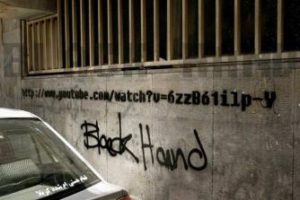
Sometimes she doesn’t even create visuals. In one of her most controversial works, she literally stenciled the link to a Youtube video that exposes the election fraud that occurred during the 2009 elections that sparked the Green Revolutions.